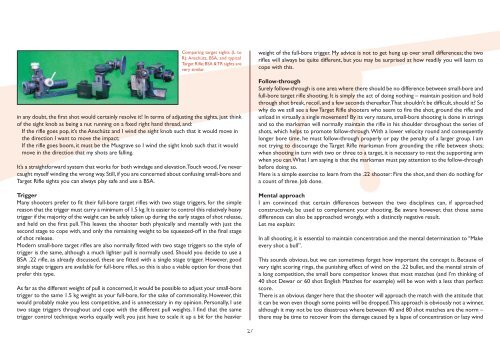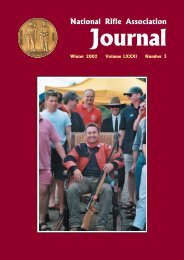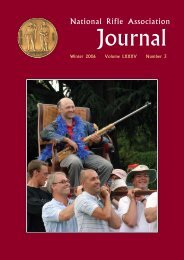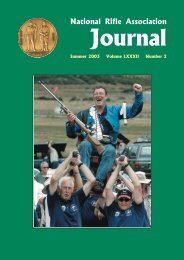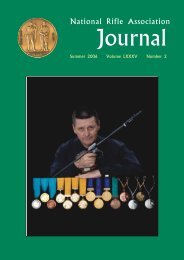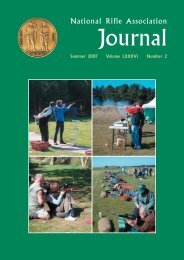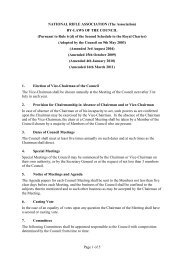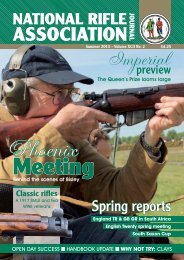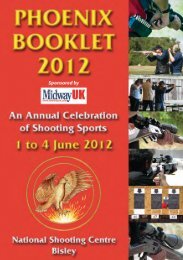The team's tour brochure. - National Rifle Association
The team's tour brochure. - National Rifle Association
The team's tour brochure. - National Rifle Association
You also want an ePaper? Increase the reach of your titles
YUMPU automatically turns print PDFs into web optimized ePapers that Google loves.
Comparing target sights (L toR): Anschütz, BSA, and typicalTarget <strong>Rifle</strong>; BSA &TR sights arevery similar.in any doubt, the first shot would certainly resolve it! In terms of adjusting the sights, just thinkof the sight knob as being a nut running on a fixed right hand thread, and:If the rifle goes pop, it’s the Anschütz and I wind the sight knob such that it would move inthe direction I want to move the impact;If the rifle goes boom, it must be the Musgrave so I wind the sight knob such that it wouldmove in the direction that my shots are falling.It’s a straightforward system that works for both windage and elevation.Touch wood, I’ve nevercaught myself winding the wrong way. Still, if you are concerned about confusing small-bore andTarget <strong>Rifle</strong> sights you can always play safe and use a BSA.TriggerMany shooters prefer to fit their full-bore target rifles with two stage triggers, for the simplereason that the trigger must carry a minimum of 1.5 kg. It is easier to control this relatively heavytrigger if the majority of the weight can be safely taken up during the early stages of shot release,and held on the first pull.This leaves the shooter both physically and mentally with just thesecond stage to cope with, and only the remaining weight to be squeezed-off in the final stageof shot release.Modern small-bore target rifles are also normally fitted with two stage triggers so the style oftrigger is the same, although a much lighter pull is normally used. Should you decide to use aBSA .22 rifle, as already discussed, these are fitted with a single stage trigger. However, goodsingle stage triggers are available for full-bore rifles, so this is also a viable option for those thatprefer this type.As far as the different weight of pull is concerned, it would be possible to adjust your small-boretrigger to the same 1.5 kg weight as your full-bore, for the sake of commonality. However, thiswould probably make you less competitive, and is unnecessary in my opinion. Personally, I usetwo stage triggers throughout and cope with the different pull weights. I find that the sametrigger control technique works equally well; you just have to scale it up a bit for the heavierweight of the full-bore trigger. My advice is not to get hung up over small differences; the tworifles will always be quite different, but you may be surprised at how readily you will learn tocope with this.Follow-throughSurely follow-through is one area where there should be no difference between small-bore andfull-bore target rifle shooting. It is simply the act of doing nothing – maintain position and holdthrough shot break, recoil, and a few seconds thereafter.That shouldn’t be difficult, should it? Sowhy do we still see a few Target <strong>Rifle</strong> shooters who seem to fire the shot, ground the rifle andunload in virtually a single movement? By its very nature, small-bore shooting is done in stringsand so the marksman will normally maintain the rifle in his shoulder throughout the series ofshots, which helps to promote follow-through.With a lower velocity round and consequentlylonger bore time, he must follow-through properly or pay the penalty of a larger group. I amnot trying to discourage the Target <strong>Rifle</strong> marksman from grounding the rifle between shots;when shooting in turn with two or three to a target, it is necessary to rest the supporting armwhen you can.What I am saying is that the marksman must pay attention to the follow-throughbefore doing so.Here is a simple exercise to learn from the .22 shooter: Fire the shot, and then do nothing fora count of three. Job done.Mental approachI am convinced that certain differences between the two disciplines can, if approachedconstructively, be used to complement your shooting. Be aware however, that those samedifferences can also be approached wrongly, with a distinctly negative result.Let me explain:In all shooting, it is essential to maintain concentration and the mental determination to “Makeevery shot a bull”.This sounds obvious, but we can sometimes forget how important the concept is. Because ofvery tight scoring rings, the punishing effect of wind on the .22 bullet, and the mental strain ofa long competition, the small bore competitor knows that most matches (and I’m thinking of40 shot Dewar or 60 shot English Matches for example) will be won with a less than perfectscore.<strong>The</strong>re is an obvious danger here that the shooter will approach the match with the attitude thatit can be won even though some points will be dropped.This approach is obviously not a winner,although it may not be too disastrous where between 40 and 80 shot matches are the norm –there may be time to recover from the damage caused by a lapse of concentration or lazy wind


